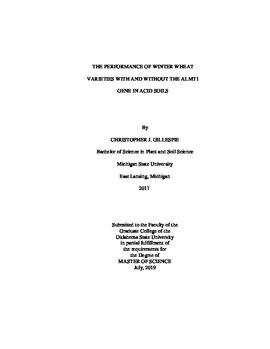| dc.description.abstract | Aluminum (Al) tolerant wheat cultivars are often utilized in the southern Great Plains to damper the yield limiting impacts of Al toxicity in acidic soils. The tolerance is mainly facilitated by Al-activated malate transporter 1 (ALMT1) gene, which increases anion permeability of wheat roots and exudes malate in the presence of Al. However, no study has explored the phenotypic incongruities of those closely related genotypes with ALMT1(+) or without ALMT1(-)]. Moreover, there is currently no quantitative ranking of Al tolerance for newly released winter wheat varieties in forage and grain dual-purpose (DP) management systems. This field scale study consisting of two locations in central Oklahoma was established to determine the Al tolerance of eight parentally related but gene divergent winter wheat varieties [(Duster (+), Lonerider (+), OK14319 (+), Jagger (+), Iba (-), Gallagher (-), Spirit Rider (-), Smith's Gold (-)]. The design structure was a split-plot in a randomized complete block with a two-way treatment (6 x 8). Main plots were amended with alum/hydrated lime to reach the following target soil pH: 4.0, 4.5, 5.0, 5.5, 6.0, and 7.0. Soil samples were collected at two months after planting in order to determine soil pH and Al saturation (Alsat). Each variety was hand clipped during December to determine fall forage yield. Grain was harvested in June to measure grain yield, wheat protein concentration, test weight and wheat moisture content of each variety. Results varied between study years and locations. Significant differences were found between the relative forage yields of ALMT1 (-) and (+) genotypes groups at Stillwater and Chickasha in Year 1 (p = 0.0042 and p = 0.0440, respectively); however, differences were not significant in Year 2 (p = 0.7228 and p = 0.7792, respectively). No significant differences were found between relative grain yields of genotype groups at Chickasha (Alsat ≤ 8%) or Stillwater (Alsat ≤ 38%) in Year 1 (p = 0.9172 and p = 0.2102, respectively) or Year 2 (p = 0.2106 and p = 0.2684, respectively). Notwithstanding genotype group affiliation, significant differences were found among varieties in their response to Al concentration and soil acidity. Similarly, the productivity of genotype groups in this study varied between years and was not wholly dependent on the presence or absence of the ALMT1 gene. Additionally, varieties differed in their yearly and environmental responses despite close parental relationships. Nevertheless, the utilization of acid tolerant winter wheat varieties has the potential to significantly reduce yield loss under acidic soil conditions with high Al concentrations. The findings in this study should equip researchers and producers with the necessary knowledge to reduce yield losses when traditional methods of soil acidity amelioration such as liming are not feasible. | |
